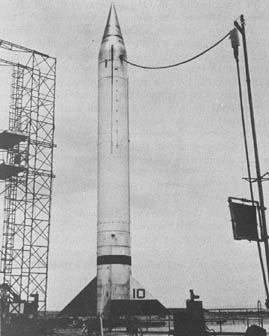Viking rocket

The Viking 10 rocket, finally flown 7 May 1954.
|
|
| Function | Research sounding rocket |
|---|---|
| Manufacturer | Glenn L. Martin Company |
| Country of origin | United States |
| Size | |
| Height | 49 ft (15 m) |
| Diameter | 32 in (810 mm) |
| Stages | 1 |
| Capacity | |
| Launch history | |
| Status | Retired |
| Launch sites |
Vikings 1-3 & 5-12 White Sands, New Mexico
|
| Total launches | 13 |
| Successes | 7 |
| Failures | 2 |
| Partial failures | 4 |
| First flight | 3 May 1949 |
| Last flight | 4 February 1955 |
| First stage | |
| Engines | Reaction Motors XLR10-RM-2 |
| Thrust | 92.5 kN (20,800 lbf) (sea level) and 110.5 kN (24,800 lbf) (vacuum) |
| Specific impulse | 179.6 seconds (1.761 km/s) |
| Burn time | 103 seconds |
| Fuel | Ethyl alcohol and liquid oxygen |
The Viking rocket series of sounding rockets were designed and built by the Glenn L. Martin Company (now Lockheed-Martin) under the direction of the U.S. Naval Research Laboratory (NRL). Twelve Viking rockets flew from 1949 to 1955.
After World War II, the United States experimented with captured German V-2 rockets as part of the Hermes project. Based on these experiments the U.S. decided in 1946 to develop its own large liquid-fueled rocket design, to be called Neptune but changed to Viking. The intent was both to provide an independent U.S. capability in rocketry, to continue the Hermes project after the V-2's were expended, and to provide a vehicle better suited to scientific research. The Navy, in particular, needed a vehicle to study the atmosphere and learn how to predict bad weather which would affect the fleet.
The V-2 would tumble in the rare atmosphere at high altitudes. Having been designed as a weapon, the V-2 carried a large payload, approximately one ton of high explosive. This was more than was considered necessary for the scientific instrument payload of a high-altitude research rocket, but in the case of the V-2, used for research, most of the payload was lead ballast required for stable flight, limiting the potential speed and altitude that could be reached with the smaller payloads typically needed for early scientific investigations.
The Naval Research Laboratory (NRL), partly at the instigation of the American Rocket Society (ARS), chose to build the advanced sounding rocket. Milton Rosen, head of the Viking project, credits rocket pioneer Robert Goddard, the ARS, the California Institute of Technology and the V-2 for the "profound influence" they had on the design of the rocket.
The Viking was the most advanced, large, liquid-fueled rocket being developed in the U.S. at the time.
The Viking was roughly half the size, in terms of mass and power, of the V-2. Both were actively guided rockets, fueled with the same propellant (Ethyl alcohol and liquid oxygen), which were fed to a single large pump-fed engine by two turbine driven pumps. The Reaction Motors XLR10-RM-2 engine was the largest liquid-fueled rocket engine developed in the United States up to that time, producing 92.5 kilonewtons (20,800 lbf) (sea level) and 110.5 kilonewtons (24,800 lbf) (vacuum) of thrust. Isp was 179.6 seconds (1.761 km/s) and 214.5 seconds (2.104 km/s) respectively, with a mission time of 103s. As was also the case for the V-2, hydrogen peroxide was converted to steam to drive the turbopump that fed fuel and oxidizer into the engine. As its V-2 counterpart, it also was regeneratively cooled.
...
Wikipedia
